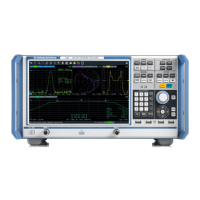Concepts and Features
R&S
®
ZNB/ZNBT
212User Manual 1173.9163.02 ─ 53
The measurement proceeds as follows:
1. The analyzer performs a frequency sweep.
2. The impulse response is calculated based on the results of the preceding fre-
quency sweep.
3. With the impulse response calculated in step 2,
a) the eye diagram is simulated.
b) the Eye Diagram Results are calculated.
c) the Eye Mask Test is evaluated (if enabled).
4. In continuous sweep mode, go back to step 2
●
The simulation progress is shown in the channel list below the eye diagram
●
In continuous sweep mode, the analyzer keeps on sweeping while the eye diagram
is being simulated and evaluated
Eye Diagram Results
The properties of the simulated eye diagram can be displayed as an info field or expor-
ted to an ASCII file.
Figure 5-15: Eye Diagram Result Info Field
The following results are available:
●
Eye Minimum and Eye Maximum
These values represent the minimum and maximum outputs of the eye diagram
processing. These values include any over- and under-shoots seen during the
symbol transitions.
●
Eye Base, Eye Top, Eye Mean, and Eye Amplitude
"Eye Base" and "Eye Top" represent the averaged voltages observed for the low
and high voltage bits, respectively. "Eye Mean" is the average of "Eye Top" and
"Eye Base", "Eye Amplitude" is the difference between "Eye Top" and "Eye Base".
●
Eye Height
This result indicates the effects of noise in reducing the vertical eye opening. It is
defined as ("Eye Top" - 3σ
Top
) - ("Eye Base" + 3σ
Base
), where σ
Top
and σ
Base
denote
the standard deviations of the observed high and low voltage levels, respectively.
Optional Extensions and Accessories

